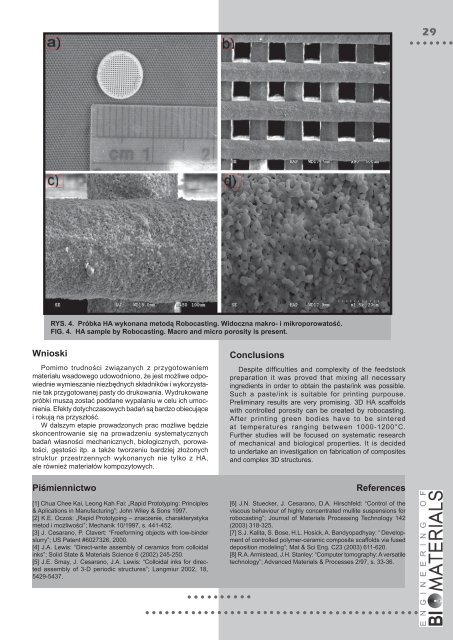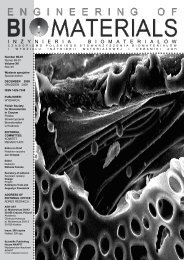62 - Polskie Stowarzyszenie BiomateriaÅów
62 - Polskie Stowarzyszenie BiomateriaÅów
62 - Polskie Stowarzyszenie BiomateriaÅów
You also want an ePaper? Increase the reach of your titles
YUMPU automatically turns print PDFs into web optimized ePapers that Google loves.
29<br />
RYS. 4. Próbka HA wykonana metodą Robocasting. Widoczna makro- i mikroporowatość.<br />
FIG. 4. HA sample by Robocasting. Macro and micro porosity is present.<br />
Wnioski<br />
Pomimo trudności związanych z przygotowaniem<br />
materiału wsadowego udowodniono, że jest możliwe odpowiednie<br />
wymieszanie niezbędnych składników i wykorzystanie<br />
tak przygotowanej pasty do drukowania. Wydrukowane<br />
próbki muszą zostać poddane wypalaniu w celu ich umocnienia.<br />
Efekty dotychczasowych badań są bardzo obiecujące<br />
i rokują na przyszłość.<br />
W dalszym etapie prowadzonych prac możliwe będzie<br />
skoncentrowanie się na prowadzeniu systematycznych<br />
badań własności mechanicznych, biologicznych, porowatości,<br />
gęstości itp. a także tworzeniu bardziej złożonych<br />
struktur przestrzennych wykonanych nie tylko z HA,<br />
ale również materiałów kompozytowych.<br />
Piśmiennictwo<br />
[1] Chua Chee Kai, Leong Kah Fai: „Rapid Prototyping: Principles<br />
& Aplications in Manufacturing”; John Wiley & Sons 1997.<br />
[2] K.E. Oczoś: „Rapid Prototyping – znaczenie, charakterystyka<br />
metod i możliwości”; Mechanik 10/1997, s. 441-452.<br />
[3] J. Cesarano, P. Clavert: “Freeforming objects with low-binder<br />
slurry”; US Patent #6027326, 2000.<br />
[4] J.A. Lewis: “Direct-write assembly of ceramics from colloidal<br />
inks”; Solid State & Materials Science 6 (2002) 245-250.<br />
[5] J.E. Smay, J. Cesarano, J.A. Lewis: “Colloidal inks for directed<br />
assembly of 3-D periodic structures”; Langmiur 2002, 18,<br />
5429-5437.<br />
Conclusions<br />
Despite difficulties and complexity of the feedstock<br />
preparation it was proved that mixing all necessary<br />
ingredients in order to obtain the paste/ink was possible.<br />
Such a paste/ink is suitable for printing purpouse.<br />
Preliminary results are very promising. 3D HA scaffolds<br />
with controlled porosity can be created by robocasting.<br />
After printing green bodies have to be sintered<br />
at temperatures ranging between 1000-1200°C.<br />
Further studies will be focused on systematic research<br />
of mechanical and biological properties. It is decided<br />
to undertake an investigation on fabrication of composites<br />
and complex 3D structures.<br />
References<br />
[6] J.N. Stuecker, J. Cesarano, D.A. Hirschfeld: “Control of the<br />
viscous behaviour of highly concentrated mullite suspensions for<br />
robocasting”; Journal of Materials Processing Technology 142<br />
(2003) 318-325.<br />
[7] S.J. Kalita, S. Bose, H.L. Hosick, A. Bandyopadhyay: “ Development<br />
of controlled polymer-ceramic composite scaffolds via fused<br />
deposition modeling”; Mat & Sci Eng. C23 (2003) 611-<strong>62</strong>0.<br />
[8] R.A. Armistead, J.H. Stanley: “Computer tomography: A versatile<br />
technology”; Advanced Materials & Processes 2/97, s. 33-36.













